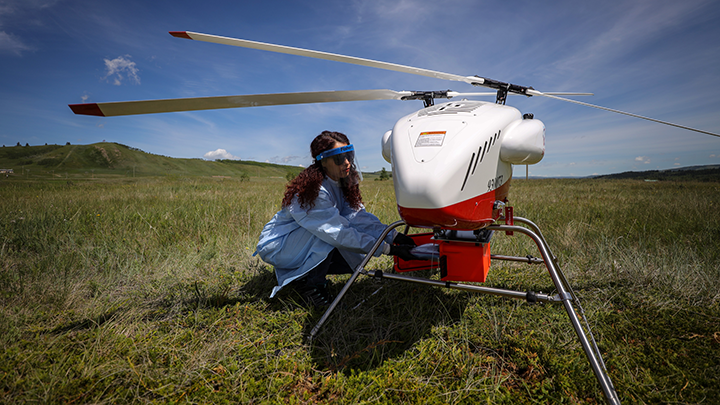
August 4, 2020

A study participant loads a drone with a test sample at the Stoney Nakoda Nations in Morley. AHS has partnered with a number of organizations to investigate the use of drones in providing a range of healthcare equipment and supplies to remote areas.
Story by Kelly Johnston | Photo by Leah Hennel
Unmanned Aerial Vehicles, more commonly referred to as drones, hold promise as a valuable tool in the battle against pandemics like COVID-19.
To explore their potential, researchers with Alberta Health Services (AHS), the University of Calgary (UC), the Southern Alberta Institute of Technology (SAIT) and Alberta Precision Laboratories (APL) have partnered with the Stoney Nakoda Nations.
These remotely-piloted drones are being used to ferry medical equipment and test kits for COVID-19 to remote areas and to more quickly connect these isolated communities to laboratories.
“We know COVID-19 testing is one of our most effective tools against its spread,” says Dr. John Conly, Medical Director of AHS and UC’s W21C Research and Innovation Centre as well as the co-principal investigator on the project.
“Many remote communities in Canada have more difficult access to testing centres and medical supplies to support rapid testing and containment. Drones can help us respond to that need.”
By chance, during a lunch break at a medical conference last November, Conly met Wade Hawkins, the lead researcher at SAIT’s Centre for Innovation and Research into Unmanned Systems (CIRUS).
Together they dreamed up the idea of drone delivery of medical supplies to remote sites across Alberta. The pandemic pressed their idea into immediate action.
“In many areas of Canada, drones must be guided and monitored with the assistance of line of sight,” says Hawkins, co-principal investigator on the project. “We hope to move beyond visual line of sight and fly from a lab or health centre directly to a remote community.”
Currently, ground transportation via APL, DynaLIFE or a third-party service carries samples to labs from remote areas in Alberta. Rural areas also use “hot shot” priority courier services when necessary to pick up samples.
Drones could complement these existing services and provide access when traditional means will not work. Stoney Nakoda Nations eagerly agreed to be involved in the research as they have three locations in Alberta, and not all areas are easy to access.
“Our reserve in Morley has multiple access points, however, our satellite reserves in Eden Valley and Big Horn are remote and a delivery system using drones could play a critical role in the health and safety of our communities,” says Ryan Robb, CEO of the Stoney Tribal Administration. “Like many remote Canadian communities, weather can play a key role with icy roads or floods creating access barriers.”
Dr. Andrew Kirkpatrick, a trauma surgeon at the Foothills Medical Centre and professor at the UC’s Cumming School of Medicine, used the drone to deliver a portable ultrasound unit.
“With this device, and access to a smartphone and connectivity, a person can be guided remotely by an expert medical professional to perform an ultrasound on themselves or to have someone at the scene perform it on them,” says Kirkpatrick.
“We’ve confirmed this system can be used to check for evidence of COVID-19 in the lungs, and I can see it being utilized for many other medical emergencies, from diagnosing broken bones to ruptured spleens.”
The researchers conducted a successful test run at the Morley reserve in June using SAIT’s unmanned SwissDrone SDO 50 V2 helicopter, which can carry a payload of up to 45 kg. The load included personal protective equipment and COVID-19 test kits. Samples used in the trial are non-infectious and pose no risk to the public.
“We were able to confirm test kits for COVID-19 can be delivered to a remote area, and the samples can survive the return to a lab with no degrading of the specimen,” adds Conly. “This could open many doors for us to reach remote and isolated locations for all medical emergencies, including the current pandemic.”
Researchers are now planning additional trial runs in the coming weeks at the Stoney Nakoda Nation’s Eden Valley and Big Horn reserves.
Should drone delivery prove effective, Conly says the project could grow from a Calgary initiative to a tool used nationally — and even globally — to respond to medical emergencies in remote and isolated areas.